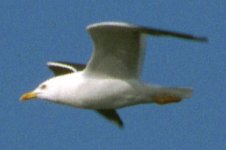Fulmar
Well-known member
I had this gull originally identified as a Lesser Black-backed Gull / Larus graellsii due to the not so heavy looking size of the bill, and the wingtips not showing much white.
On second thoughts however I changed my mind to Great Black-backed Gull / Larus marinus, because of the fleshy-looking color of the legs (if that is not caused by being in the shadow?), and the very dark color of the wings.
It is flying over the North Sea not far from the Dutch coast on June 16.
Anyone likes to comment?
Peter
On second thoughts however I changed my mind to Great Black-backed Gull / Larus marinus, because of the fleshy-looking color of the legs (if that is not caused by being in the shadow?), and the very dark color of the wings.
It is flying over the North Sea not far from the Dutch coast on June 16.
Anyone likes to comment?
Peter
Attachments
Last edited:





